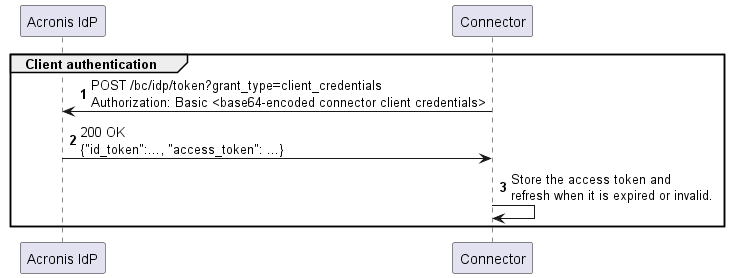API Authentication
Note
You create API key credentials when you create the CyberApp, and you can regenerate the API key from the CyberApp settings section.
Authorization header according to the Bearer Authentication scheme.Authorization header is expired or your API client is disabled, the API will respond with a 401 status code and error details.Important
Authenticate in the data centers where the CyberApp is deployed.
Make authenticated requests to the corresponding data center.
Interaction diagram

Step-by-step procedure
Store the API client credentials that you have obtained when you created the CyberApp in the
client_idandclient_secretvariables.>>> client_id = '<your client ID>' >>> client_secret = '<your client secret>'
Store the data center URL where the CyberApp will be deployed. This URL will be used for authentication and requests:
>>> datacenter_url = 'https://eu8-cloud.acronis.com'
Encode the client ID and client secret string using Base64 encoding and store the result in a variable:
>>> from base64 import b64encode # Used for encoding to Base64 >>> encoded_client_creds = b64encode(f'{client_id}:{client_secret}'.encode('ascii'))
Define a variable named
basic_auth, and then assign an object with theAuthorizationkey containing authentication data to this variable:>>> basic_auth = { ... 'Authorization': 'Basic ' + encoded_client_creds.decode('ascii') ... }
Send a POST request to the
/bc/idp/tokenendpoint. The request should contain authentication data in the request headers and contain thegrant_typefield set toclient_credentialsin its body:>>> response = requests.post( ... f'{base_url}/bc/idp/token', ... headers={'Content-Type': 'application/x-www-form-urlencoded', **basic_auth}, ... data={'grant_type': 'client_credentials'}, ... )
Check the status code of the response:
>>> response.status_code 200
Status code 200 means that the platform has authenticated the API client and issued the API client a token for accessing API endpoints (an access token). The response body text contains an encoded JSON object with this token and some other information.
Convert the JSON text that the response body contains to an object, and then store this object in a variable named
token_info:>>> token_info = response.json() >>> pprint.pprint(token_info) {'access_token': 'eyJ0eXAiOiJKV1QiLCJhbGciOiJSUzI1NiIsImtpZCI6ImMwMD...', 'expires_on': 1562910964, 'id_token': 'eyJ0eXAiOiJKV1QiLCJhbGciOiJSUzI1NiIsImtpZCI6IjI5ZT...', 'token_type': 'bearer'}
Define a variable named
auth, and then assign an object, that will be used for constructing anAuthorizationheader in API requests, to this variable:>>> auth = {'Authorization': 'Bearer ' + token_info['access_token']} >>> auth {'Authorization': 'Bearer eyJ0eXAiOiJKV1QiLCJhbGciOiJSUzI1NiIsImtpZCI6ImMwMD...'}
You will need to specify this variable in every request to the API as follows:
requests.get(f'{base_url}/clients/{client_id}', headers=auth)